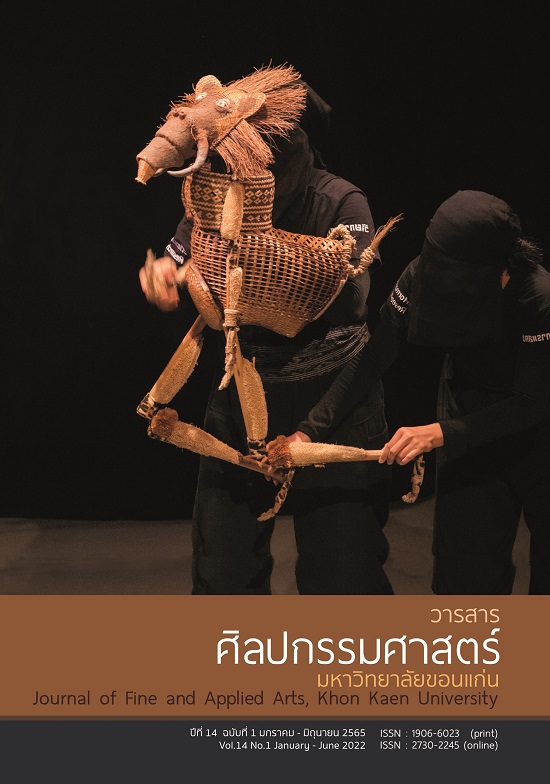Role and Form of Isan Contemporary Music
Main Article Content
Abstract
The research on roles and music form of the contemporary Isan music aimed to study the forms, concepts, and inspiration for creating the contemporary Isan music, and examine the roles and music form of the contemporary Isan music. The document study and the interview with Mor Lam (northeastern-style singer), scholar and audience were applied. Descriptive analysis was used to present the research results.
Regarding the forms, concepts and inspiration for creating the contemporary Isan music, Song 1 “Sud Sanaan”, the creator allowed the musician to play freely and only determined the song that made the performer feel emotional. For Song 2 “Hoi Hug”, it was Isan music but was unique in using the silence and the sound of music to fascinate the audience with the appropriate rhythm. For Song 3 “Mor Lam Phuen”, it was discovered that the concept was to repeat the pattern using a reed mouth-organ to sing the story. It was the integration of traditional and contemporary Isan music ensembles. In regard to the inspiration, it was found out that the contemporary Isan music was partial way of life of Isan people and the interested person, creators, artists, and scholars. It had various forms to serve the society based on the creator demand which existed and might change in the future depending on the impacts, the culture movement and acceptance, as well as the changing form of music styles in the world of technology. Furthermore, regarding the roles and music form of the contemporary Isan music, it was found that it served the society in terms of traditions, entertainment, education, tourism, arts and culture propagation in Thailand and overseas, as well as for the economic purpose. The roles of contemporary Isan music at the Greater Mekong region, in ASEAN context and for the performance illustrated that the use of traditional Isan music band was different depending on the creator. For instance, in the stage play “Sud Sanaan” was the form of concert band which included the reed mouth-organ, Pong lang, Wot (a circular panpipe), drum, moon-shaped bell, vina, to play along with the presentation of the performers who was singing Mor Lam. The role of contemporary Isan music in Mor Lam Phuen was to link the traditional Isan Mor Lam Phuen to the creator of contemporary Isan music. It was the convention to use the performance to reflect the meaning of the verse. The rhythm and melody was slow and fun. The harmony of contemporary Isan music instrument used the conventional Isan music instrument whereas the western music instrument bass, guitar, keyboard and saxophone that were mostly found were the intervals from E (3) to G (5). Moreover, the musical arrangement was the integration with the western music culture.
Article Details

This work is licensed under a Creative Commons Attribution-NonCommercial-NoDerivatives 4.0 International License.
Content and information in articles published in the Journal of Fine and Applied Arts of Khon Kaen University is regarded as the opinion and sole responsibility of the author(s) directly; therefore, editors are not obliged to agree to or share any responsibility with regard to the content and information that appears within these articles.
All articles, information, content, image, etc. that have been published in the Journal of Fine and Applied Arts of Khon Kaen University is the copyright of the Journal of Fine and Appllied Arts of Khon Kaen University. Any person or organization who wishes to distribute all or parts of the articles for further dissemination or other usage must first receive permission from the Journal of Fine and Applied Arts of Khon Kaen University before proceeding to do so.
References
จันทิมา นิลทองคำ. (2540). การศึกษาวิเคราะห์วงดนตรีไทยร่วมสมัย กรณีศึกษาวงฟองน้ำ. วิทยานิพนธ์ปริญญาศิลปศาสตรมหาบัณฑิต สาขาวิชาวัฒนธรรมศึกษา บัณฑิตวิทยาลัย มหาวิทยาลัยมหิดล.
เจริญชัย ชนไพโรจน์. (2526). หมอลำ-หมอแคน. กรุงเทพฯ : อักษรสมัย.
อานันท์ นาคคง. (2556). รายงานวิจัยฉบับสมบูรณ์การศึกษาวงดนตรีไทยร่วมสมัยและผลงานดนตรีไทยร่วมสมัยในสังคมไทยปัจจุบัน. กรุงเทพฯ : สำนักงานศิลปวัฒนธรรมร่วมสมัย กระทรวงวัฒนธรรม.


